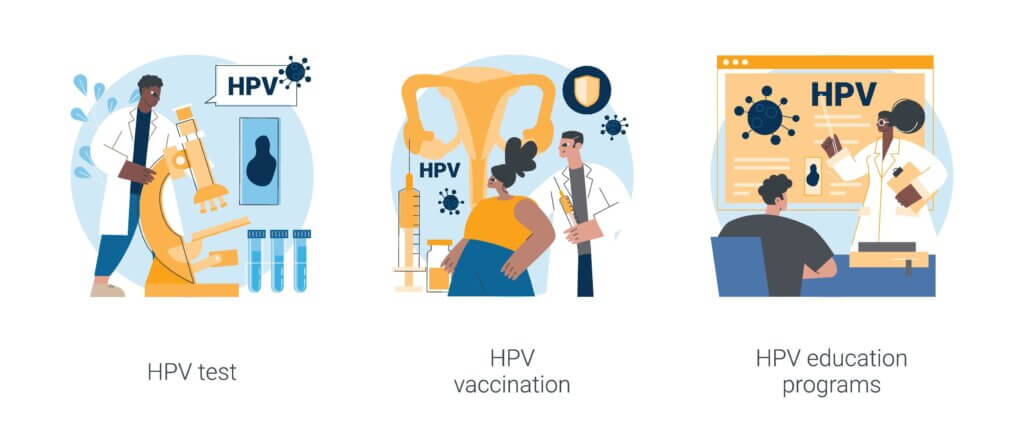Cervical cancer is caused by a virus called HPV (human papilloma virus) that is spread through sexual contact. For many people, the virus is cleared by the immune system. But if it isn’t, it can develop into cancer.
The virus can be detected through HPV screening that inspects a sample of cervical tissue for the virus. The test is ordered by a primary care physician or gynecologist who typically collects a sample of cervical tissue as part of a pelvic exam. However, HPV tests can also be done using self-collected samples.
Cancer of the cervix affects about 13,960 people per year in the United States. The number of cases has dropped dramatically since the 1970s due to screening and due to the HPV vaccine, which prevents infections.
However, disparities persist. For example:
- People from historically marginalized groups have lower rates of receiving the HPV vaccine.
- Black patients are more likely to be diagnosed with more advanced disease and face a higher risk of death from the disease than white patients.
- Hispanic/Latinx patients and Native American patients are also at a higher risk of death.
- People who are uninsured, who don’t have a regular healthcare provider, who have experienced trauma, or who have been historically marginalized often experience delays receiving a definitive diagnosis, and therefore may experience delays in treatment.
Dana-Farber gynecologic oncologists are working to reduce disparities by lowering the barriers patients face when trying to access screening and care. One strategy supported by Dana-Farber’s Cancer Care Equity Program and the Gynecologic Oncology Program is the employment of patient navigators who can help patients in many ways.
Patient navigators at Dana-Farber have helped patients by:
- Reaching out and learning specifically about a patient’s needs.
- Arranging transportation.
- Providing appointment reminders.
- Attending appointments to provide support.
- Arranging translators.
- Connecting patients to social workers and resource that can help with food insecurity and housing.
“If you are encountering obstacles that are interfering with your care, ask your cancer team if they have a patient navigator,” says Alexi Wright, MD, MPH, a gynecologic oncologist and director of Gynecologic Oncology Outcomes Research in the Gynecologic Oncology Program at Dana-Farber. “Navigators are increasingly available and can make a big difference for some of the most vulnerable members of our community.”
Here are other things you can do to prevent and manage cervical cancer.
For those under 26: Focus on prevention
The HPV vaccine is a recommended routine vaccination at age 11 or 12, and can be started as early as age 9, according to the Centers for Disease Control and Prevention. People as old as 26 can receive the vaccine.
“Cervical cancer is a preventable disease that we must eradicate within our lifetime with vaccination,” says Wright.

Adults: Focus on screening
Cervical cancer is highly treatable when it is found early, so screening regularly is essential. Any person with a cervix should be screened regularly between the ages of 21 and 65, regardless of their current sexual activity.
Screening for cervical cancer is typically done during a pelvic exam performed by a primary care physician or a gynecologist. The test can include:
- A Pap test, which checks for changes in the cells of your cervix that could turn into cancer.
- An HPV test, which tests for the presence of the HPV virus that causes cervical cancer.
For patients who want to be tested but prefer not to have a pelvic exam, talk to your doctor about a self-collection kit for you to use to complete HPV testing.
The American College of Obstetricians and Gynecologists recommendation for cervical cancer screening is:
- Ages 21-29: Pap test every 3 years.
- Ages 30-65: A Pap test every 3 years or HPV testing every 5 years; or co-testing with an HPV test and a Pap test every 5 years.
- Ages 66 and over: No screening required if prior tests have been negative.
For patients who have had a hysterectomy with removal of the cervix, no screening is required if there is no history of precancerous cervical lesions or cervical cancer.
Screening is preventive medicine and should be covered by all forms of medical insurance. In addition, many states provide free screening and diagnostic services for breast and cervical cancer for people who qualify based on income, insurance status, and residency.
Learn more about free breast and cervical cancer screening and resources in Massachusetts. Help is available by phone in English, Spanish, Portuguese, Vietnamese, and Haitian Creole.
Older adults: Continue gynecologic care
Approximately 20% of cervical cancer cases are diagnosed in people over age 65, so it is important to continue paying attention to your gynecologic health as you age.
Pap tests and HPV tests are not recommended for patients over 65, but regular pelvic exams should be continued. If you have a new sexual partner, talk to your doctor about whether a Pap test or HPV test is recommended.
If you are diagnosed with cervical cancer
If you are diagnosed with cervical cancer, follow up with an oncologist immediately to learn more and begin treatment.
Learn more about cervical cancer diagnosis and treatment at Dana-Farber.
If you are running into challenges that are preventing you from getting treatment — including concerns about insurance, language barriers, transportation challenges, or a living situation that makes cancer care difficult — please request help from your providers.
At Dana-Farber, our patient navigators have helped nearly 100 patients over the past year access many resources. Patient navigators have helped reduce the number of patients who miss appointments by helping with transportation, care coordination and logistics, and reminders.
Transportation seems small but it is a big barrier that can prevent patients from getting to appointments. For instance, Uber rides funded by Dana-Farber’s Cancer Care Equity Program helped patients without transportation get to their appointments.
“We want to make sure there’s nothing stopping patients from getting the care they need,” says Imani Holloman, a patient navigator for the Cancer Care Equity Program in the Gynecologic Oncology Program at Dana-Farber. “This work is beautiful and gives me a chance to be there for people who need it. Sometimes you just need a hand to hold through it all.”
About the Medical Reviewer

Dr. Wright is an Associate Professor of Medicine at Harvard Medical School and Dana-Farber Cancer Institute. She received her Medical Degree from University of Pennsylvania and completed a residency in Internal Medicine at Brigham and Women’s Hospital and a Medical Oncology fellowship at Dana-Farber Cancer Institute. She also obtained a Masters in Public Health at the Harvard School of Public Health. In 2009 she joined the faculty of Dana-Farber Cancer Institute, where she is a practicing medical oncologist who specializes in gynecologic oncology and health outcomes research.

“This site is a treasure! I’d love to receive your newsletter updates.”
Hi Melaine,
Thank you for your feedback, we will add you to our list to receive newsletters.
Best,
BL